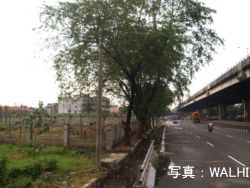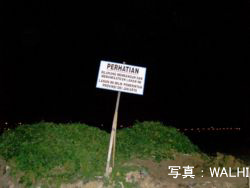Policy of Green Space Area and Urban Poor Eviction in Political ecology perspektive Studi case: eviction of "Bersih, Manusiawi dan Berwibawa"Park in North Jakarta.
 |
Indonesian for the Environment Forum (WALHI)Friends of the Earth Indonesia | |
 |
Khalisah Khalid | |
 |
||
 |
JPY 100,000 |
Research Background Final Report (abstract) Others

"The greening" area with trees

The signboard says "Land usage is prohibited."
Research Background
Jakarta's is the picture of people's livelihoods entities, as drawn by Lance Castle (2007) that it looks like a melting pot, where God created Indonesian peoples. The amounts of 12 billion peoples are living in Jakarta today. As a capital city of Indonesia, which become a central of governance and economic growth barometer in Indonesia, Jakarta's development policy and centralized economic endorse urbanization from many area of Indonesia to come to the city for finding an opportunity for their livelihoods. Many people from many villages do not have an appropriate skills and capacities to struggle their live in Jakarta. In fact, the people are working as cheap labors and in informal sectors like pedagang kaki lima . There are about 250.000 peoples come to Jakarta every year. From the 12 billions peoples of Jakarta, 405, 7 thousands of them live in the slum area.
As a result,the urban poor can not access land. They use state land to build their temporary place to stay even though it illegal according to Jakarta's government regulation. Jakarta master plan describe that the utilization of green space area is under categorized: green road, nearby the rivers area, and some dangerous places. Even though the government categorized them as an illegal resident, in contrast, they are served by public facilities from the government. For example, they can easily to get Jakarta identity card and household card.
The Jakarta governments perform an eviction policy to solve environment and social of problems and said that urban poor communities affect all worst environmental condition of Jakarta. All conditions could see in different ways, namely the centralistic of economic policy paradigm. The government also use the United Nation Habitat campaign program called "city without slum" which means that urban poor community should out from Jakarta. In implementing this policy, the Jakarta government was awarded by the UN Habitat Scroll of Honours in 2005.
Urban Poor Consortium (UPC) and legal aid of Jakarta (LBH Jakarta) reported the eviction data to Center on Housing Rights and Eviction (COHRE). They reported that on the year of 2000-2005 there are 92,720 persons lost their houses and livelihood, and the amounts of threatened persons are 1,592,011. This report shows that Jakarta is the highest city evicting urban poor communities, and it proofed that UN Habitat slum programs have been abused the human rights.
Since 2007,the government argued to restore environment degradation to evict urban poor houses,within the "need" of green space areas in Jakarta such as air pollution and flood. Master plan of DKI Jakarta government for 2000-2012, targeted 13.94% areas will be greened. In order to fulfill this target, Jakarta government has some policies (regional regulation), in which eviction of urban poor communities is one of that. For 2008 budget, the Park Agency of DKI Jakarta proposed 40 billions rupiahs from regional budget (APBD) and 16 housing areas will evict to fulfill 13% target for green space area.
The changing of green area function to become apartment, super block, department store, mall, and others commercial areas show that the government tend to support private sectors rather than for public facilities purposes. For development reason, the land use policy can be changed anytime along with the ‘request' from private sector. Capital interest was facilitated by the government. However, whenever the impact of those policies end with flood , the government blamed it to the poor people that live in '
restricted area' under the local regulation. The river borders and the bridge spaces are the examples of the restricted area. The green space such as park, mangrove forest, green belt area, and other open spaces are occupied easily for capital purposes.
[January 2009]
Final Report (abstract)
Location
Others
